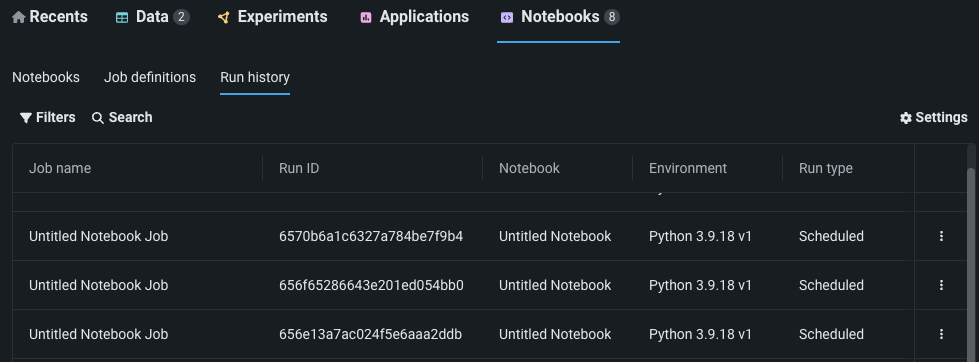Code-first (V10.0)¶
April 29, 2024
The DataRobot v10.0 release includes many new features and capabilities for code-first users, described below. See additional details of Release 10.0 in the data and modeling and MLOps release notes.
Code-first features
| Name | GA | Preview |
|---|---|---|
| Notebooks | ||
| Manage notebook file systems with codespaces | ✔ | |
| Notebook scheduling now GA | ✔ | |
| Notebook terminals now GA | ✔ | |
| API enhancements | ||
| MLOps Python package migration | ✔ | |
| Python client v3.4 | ✔ | |
| DataRobot REST API v2.33 | ✔ | |
Notebooks¶
Manage notebook file systems with codespaces¶
Now generally available, DataRobot Workbench includes codespaces to enhance the code-first experience, especially when working with DataRobot Notebooks. A codespace, similar to a repository or folder file tree structure, can contain any number of files and nested folders. Within a codespace, you can open, view, and edit multiple notebook and non-notebook files at the same time. You can also execute multiple notebooks in the same container session (with each notebook running on its own kernel).
For Managed AI Platform users, DataRobot provides backup functionality and retention policies for codespaces. DataRobot takes snapshots of the codespace volume on session shutdown and on codespace deletion and will retain the contents for 30 days in the event you want to restore the codespace data.
Notebook scheduling now GA¶
Now generally available, notebook scheduling for executing and monitoring notebook jobs adds the ability to download run results. Using notebook scheduling, you can automate your code-based workflows by configuring notebooks to run on a schedule in non-interactive mode. Notebook scheduling is managed by notebook jobs that you can create directly from the DataRobot Notebooks interface. Additionally, you can parameterize a notebook job to enhance the automation experience enabled by notebook scheduling. By defining certain values in a notebook as parameters, you can provide inputs for those parameters when a notebook job runs instead of having to continuously modify the notebook itself to change the values for each run.
Notebook terminals now GA¶
Now generally available, you can access terminals integrated into DataRobot Notebooks. While Notebooks already provide the possibility to run code, an integrated terminal allows you to execute commands to run scripts or install packages within DataRobot. The terminal is accessed directly from a notebook by selecting the terminal icon in the side panel. You can run multiple terminal windows for one notebook. Terminal windows only last for the duration of the notebook session and they will not persist when you access the notebook at a later time.
API¶
MLOps Python package migration¶
In 10.0, the import path for the file path for the datarobot-mlops and datarobot-mlops-connected-client packages import path is changing from import datarobot.mlops.mlops to import datarobot_mlops.mlops. This change resolves issues where the datarobot package and the mlops packages conflict with each other when installed into the same Python environment. You will need to manually update your import(s).
Imports can be revised as follows:
try:
from datarobot_mlops.mlops import MLOps
except ImportError:
from datarobot.mlops.mlops import MLOps
Python client v3.4¶
v3.4 for DataRobot's Python client is now generally available. For a complete list of changes introduced in v3.4, view the Python client changelog.
DataRobot REST API v2.33¶
DataRobot's v2.33 for the REST API is now generally available. For a complete list of changes introduced in v2.33, view the REST API changelog.
All product and company names are trademarks™ or registered® trademarks of their respective holders. Use of them does not imply any affiliation with or endorsement by them.

